The Influence of Branched Chain Length on Different Causticized Starches for the Depression of Serpentine in the Flotation of Pentlandite
Abstract
1. Introduction
2. Materials and Methods
2.1. Samples and Reagents
2.2. Causticization of Starch
2.3. Determination of Branched Chain Length of Amylopectin
2.4. Micro-Flotation Experiments
2.5. Zeta Potential Measurements
2.6. FT-IR Experiments
2.7. XPS Analysis
3. Results
3.1. Branched Chain Length of Amylopectin
3.2. Flotation Experiments Results
3.3. Zeta Potential Measurements Results
3.4. FT-IR Experiments Results
3.5. XPS Analysis Results
4. Conclusions
- The results of the flotation experiments fully illustrated that the depression effect of causticized starches on serpentine were ranked as follows: cassava starch > corn starch > potato starch > wheat starch > rice starch.
- The average branched chain length was arranged in the following order: cassava starch > corn starch > potato starch > wheat starch > rice starch, and the depression effect of causticized starches on serpentine exhibited a positive correlation with the average branched chain length.
- Starch depressants depress the serpentine in the flotation system by combining the oxygen atoms on the oxygen-containing hydrocarbon chain with the Mg atoms on serpentine surface. Moreover, causticized starches with longer branched chains were adsorbed more strongly on serpentine surface, and thus had a better depression effect.
Author Contributions
Funding
Data Availability Statement
Conflicts of Interest
References
- Ojogbo, E.; Ogunsona, E.O.; Mekonnen, T.H. Chemical and physical modifications of starch for renewable polymeric materials. Mater. Today Sustain. 2020, 7–8, 25. [Google Scholar] [CrossRef]
- Le Corre, D.; Bras, J.; Dufresne, A. Starch Nanoparticles: A Review. Biomacromolecules 2010, 11, 1139–1153. [Google Scholar] [CrossRef] [PubMed]
- Singh, S.; Singh, N.; Isono, N.; Noda, T. Relationship of Granule Size Distribution and Amylopectin Structure with Pasting, Thermal, and Retrogradation Properties in Wheat Starch. J. Agric. Food Chem. 2010, 58, 1180–1188. [Google Scholar] [CrossRef] [PubMed]
- Jane, J.-l.; Atichokudomchai, N.; Park, J.-H.; Suh, D.-S. Effects of Amylopectin Structure on the Organization and Properties of Starch Granules. In Advances in Biopolymers; ACS Symposium Series: Washington, DC, USA, 2006; pp. 146–164. [Google Scholar]
- Buleon, A.; Colonna, P.; Planchot, V.; Ball, S. Starch granules: Structure and biosynthesis. Int. J. Biol. Macromol. 1998, 23, 85–112. [Google Scholar] [CrossRef]
- Copeland, L.; Blazek, J.; Salman, H.; Tang, M.C. Form and functionality of starch. Food Hydrocoll. 2009, 23, 1527–1534. [Google Scholar] [CrossRef]
- Lin, L.; Guo, K.; Zhang, L.; Zhang, C.; Liu, Q.; Wei, C. Effects of molecular compositions on crystalline structure and functional properties of rice starches with different amylopectin extra-long chains. Food Hydrocoll. 2019, 88, 137–145. [Google Scholar] [CrossRef]
- Jane, J.; Chen, Y.Y.; Lee, L.F.; McPherson, A.E.; Wong, K.S.; Radosavljevic, M.; Kasemsuwan, T. Effects of amylopectin branch chain length and amylose content on the gelatinization and pasting properties of starch. Cereal Chem. 1999, 76, 629–637. [Google Scholar] [CrossRef]
- Menzel, C.; Andersson, M.; Andersson, R.; Vazquez-Gutierrez, J.L.; Daniel, G.; Langton, M.; Gallstedt, M.; Koch, K. Improved material properties of solution-cast starch films: Effect of varying amylopectin structure and amylose content of starch from genetically modified potatoes. Carbohydr. Polym. 2015, 130, 388–397. [Google Scholar] [CrossRef]
- Wang, H.; Feng, L.; Manica, R.; Liu, Q. Selective depression of millerite (β-NiS) by polysaccharides in alkaline solutions in Cu-Ni sulphides flotation separation. Miner. Eng. 2021, 172, 107139. [Google Scholar] [CrossRef]
- Qin, W.; Wei, Q.; Jiao, F.; Yang, C.; Liu, R.; Wang, P.; Ke, L. Utilization of polysaccharides as depressants for the flotation separation of copper/lead concentrate. Int. J. Min. Sci. Technol. 2013, 23, 179–186. [Google Scholar] [CrossRef]
- Khoso, S.A.; Gao, Z.; Tian, M.; Hu, Y.; Sun, W. Adsorption and depression mechanism of an environmentally friendly reagent in differential flotation of Cu–Fe sulphides. J. Mater. Res. Technol. 2019, 8, 5422–5431. [Google Scholar] [CrossRef]
- Sarquís, P.E.; Menéndez-Aguado, J.M.; Mahamud, M.M.; Dzioba, R. Tannins: The organic depressants alternative in selective flotation of sulfides. J. Clean. Prod. 2014, 84, 723–726. [Google Scholar] [CrossRef]
- Li, M.; Liu, J.; Hu, Y.; Gao, X.; Yuan, Q.; Zhao, F. Investigation of the specularite/chlorite separation using chitosan as a novel depressant by direct flotation. Carbohydr. Polym. 2020, 240, 116334. [Google Scholar] [CrossRef] [PubMed]
- Zhang, H.; Xu, Z.; Sun, W.; Chen, D.; Li, S.; Han, M.; Yu, H.; Zhang, C. Selective adsorption mechanism of dodecylamine on the hydrated surface of hematite and quartz. Sep. Purif. Technol. 2021, 275, 119137. [Google Scholar] [CrossRef]
- Zhang, X.; Han, Y.; Gao, P.; Gu, X.; Wang, S. Depression Mechanism of a Novel Depressant on Serpentine Surfaces and Its Application to the Selective Separation of Chalcopyrite from Serpentine. Miner. Process. Extr. Metall. Rev. 2020, 43, 373–379. [Google Scholar] [CrossRef]
- Bremmell, K.E.; Fornasiero, D.; Ralston, J. Pentlandite–lizardite interactions and implications for their separation by flotation. Colloids Surf. A Physicochem. Eng. Asp. 2005, 252, 207–212. [Google Scholar] [CrossRef]
- Zhang, C.; Liu, C.; Feng, Q.; Chen, Y. Utilization of N -carboxymethyl chitosan as selective depressants for serpentine on the flotation of pyrite. Int. J. Miner. Process. 2017, 163, 45–47. [Google Scholar] [CrossRef]
- Cao, J.; Luo, Y.-C.; Xu, G.-Q.; Qi, L.; Hu, X.-Q.; Xu, P.-F.; Zhang, L.-Y.; Cheng, S.-Y. Utilization of starch graft copolymers as selective depressants for lizardite in the flotation of pentlandite. Appl. Surf. Sci. 2015, 337, 58–64. [Google Scholar] [CrossRef]
- Long, T.; Zhao, H.; Wang, Y.; Yang, W.; Deng, S.; Xiao, W.; Lan, X.; Wang, Q. Synergistic mechanism of acidified water glass and carboxymethyl cellulose in flotation of nickel sulfide ore. Miner. Eng. 2022, 181, 107547. [Google Scholar] [CrossRef]
- Beattie, D.A.; Huynh, L.; Kaggwa, G.B.; Ralston, J. Influence of adsorbed polysaccharides and polyacrylamides on talc flotation. Int. J. Miner. Process. 2006, 78, 238–249. [Google Scholar] [CrossRef]
- Sheng, Q.; Yin, W.; Ma, Y.; Liu, Y.; Wang, L.; Yang, B.; Sun, H.; Yao, J. Selective depression of talc in azurite sulfidization flotation by tamarind polysaccharide gum: Flotation response and adsorption mechanism. Miner. Eng. 2022, 178, 107393. [Google Scholar] [CrossRef]
- Zhao, K.; Gu, G.; Wang, C.; Rao, X.; Wang, X.; Xiong, X. The effect of a new polysaccharide on the depression of talc and the flotation of a nickel–copper sulfide ore. Miner. Eng. 2015, 77, 99–106. [Google Scholar] [CrossRef]
- Shortridge, P.G.; Harris, P.J.; Bradshaw, D.J.; Koopal, L.K. The effect of chemical composition and molecular weight of polysaccharide depressants on the notation of talc. Int. J. Miner. Process. 2000, 59, 215–224. [Google Scholar] [CrossRef]
- Beattie, D.A.; Huynh, L.; Kaggwa, G.B.N.; Ralston, J. The effect of polysaccharides and polyacrylamides on the depression of talc and the flotation of sulphide minerals. Miner. Eng. 2006, 19, 598–608. [Google Scholar] [CrossRef]
- Tian, F.; Li, P.; Cao, Y.; Hao, H.; Peng, W.; Fan, G. Selective depression of low-molecular-weight carboxylated starch in flotation separation of forsterite and ilmenite. Colloids Surf. A Physicochem. Eng. Asp. 2022, 648, 129080. [Google Scholar] [CrossRef]
- Beaussart, A.; Parkinson, L.; Mierczynska-Vasilev, A.; Beattie, D.A. Adsorption of modified dextrins on molybdenite: AFM imaging, contact angle, and flotation studies. J. Colloid Interface Sci. 2012, 368, 608–615. [Google Scholar] [CrossRef] [PubMed]
- Chimonyo, W.; Fletcher, B.; Peng, Y. The differential depression of an oxidized starch on the flotation of chalcopyrite and graphite. Miner. Eng. 2020, 146, 106114. [Google Scholar] [CrossRef]
- Li, H.P.; Zhang, S.S.; Jiang, H.; Li, B. Effect of modified starches on depression of diaspore. Trans. Nonferrous Met. Soc. China 2010, 20, 1494–1499. [Google Scholar] [CrossRef]
- Feng, B.; Peng, J.; Zhang, W.; Luo, G.; Wang, H. Removal behavior of slime from pentlandite surfaces and its effect on flotation. Miner. Eng. 2018, 125, 150–154. [Google Scholar] [CrossRef]
- Alvarez-Silva, M.; Uribe-Salas, A.; Waters, K.E.; Finch, J.A. Zeta potential study of pentlandite in the presence of serpentine and dissolved mineral species. Miner. Eng. 2016, 85, 66–71. [Google Scholar] [CrossRef]
- Cao, J.; Hu, X.-Q.; Luo, Y.-C.; Qi, L.; Xu, G.-Q.; Xu, P.-F. The role of some special ions in the flotation separation of pentlandite from lizardite. Colloids Surf. A Physicochem. Eng. Asp. 2016, 490, 173–181. [Google Scholar] [CrossRef]
- Huang, J.W.; Zhang, C.Q. Inhibiting effect of citric acid on the floatability of serpentine activated by Cu(II) and Ni(II) ions. Physicochem. Probl. Miner. Process. 2019, 55, 960–968. [Google Scholar] [CrossRef]
- Ai, G.; Huang, K.; Liu, C.; Yang, S. Exploration of amino trimethylene phosphonic acid to eliminate the adverse effect of seawater in molybdenite flotation. Int. J. Min. Sci. Technol. 2021, 31, 1129–1134. [Google Scholar] [CrossRef]
- Panda, L.; Venugopal, R.; Mandre, N.R. Selective Flocculation of Chromite Tailings. Trans. Indian Inst. Met. 2021, 74, 619–628. [Google Scholar] [CrossRef]
- Rohem Peçanha, E.; da Fonseca de Albuquerque, M.D.; Antoun Simão, R.; de Salles Leal Filho, L.; de Mello Monte, M.B. Interaction forces between colloidal starch and quartz and hematite particles in mineral flotation. Colloids Surf. A Physicochem. Eng. Asp. 2019, 562, 79–85. [Google Scholar] [CrossRef]
- Ren, Z.T.; He, S.Z.; Zhao, N.; Zhai, H.; Liu, Q.C. A sucrose non-fermenting-1-related protein kinase-1 gene, IbSnRK1, improves starch content, composition, granule size, degree of crystallinity and gelatinization in transgenic sweet potato. Plant Biotechnol. J. 2019, 17, 21–32. [Google Scholar] [CrossRef]
- Nishi, A.; Nakamura, Y.; Tanaka, N.; Satoh, H. Biochemical and genetic analysis of the effects of amylose-extender mutation in rice endosperm. Plant Physiol. 2001, 127, 459–472. [Google Scholar] [CrossRef]
- Liu, W.-C.; Halley, P.J.; Gilbert, R.G. Mechanism of Degradation of Starch, a Highly Branched Polymer, during Extrusion. Macromolecules 2010, 43, 2855–2864. [Google Scholar] [CrossRef]
- Zhou, W.Z.; Yang, J.; Hong, Y.; Liu, G.L.; Zheng, J.L.; Gu, Z.B.; Zhang, P. Impact of amylose content on starch physicochemical properties in transgenic sweet potato. Carbohydr. Polym. 2015, 122, 417–427. [Google Scholar] [CrossRef]
- Tang, X.; Chen, Y. Using oxalic acid to eliminate the slime coatings of serpentine in pyrite flotation. Miner. Eng. 2020, 149, 106228. [Google Scholar] [CrossRef]
- Santacruz, S.; Koch, K.; Svensson, E.; Ruales, J.; Eliasson, A.C. Three underutilised sources of starch from the Andean region in Ecuador Part 1. Physico-chemical characterisation. Carbohydr. Polym. 2002, 49, 63–70. [Google Scholar] [CrossRef]
- Yoo, S.H.; Perera, C.; Shen, J.F.; Ye, L.Y.; Suh, D.S.; Jane, J.L. Molecular Structure of Selected Tuber and Root Starches and Effect of Amylopectin Structure on Their Physical Properties. J. Agric. Food Chem. 2009, 57, 1556–1564. [Google Scholar] [CrossRef] [PubMed][Green Version]
- Genkina, N.K.; Wikman, J.; Bertoft, E.; Yuryev, V.P. Effects of structural imperfection on gelatinization characteristics of amylopectin starches with A- and B-type crystallinity. Biomacromolecules 2007, 8, 2329–2335. [Google Scholar] [CrossRef] [PubMed]
- Jane, J.; Atichokudomchai, N.; Suh, D.S. Internal structures of starch granules revealed by confocal laser-light scanning microscopy. In Starch: Progress in Structural Studies, Modifications and Applications; Polish Society of Food Technologists: Malopolsks, Poland, 2004; pp. 147–156. [Google Scholar]
- Marins, T.F.; Rodrigues, O.M.S.; Reis, E.L.; Beltrao, J.G. Utilising starches from sugarcane and cassava residues as hematite depressants. Miner. Eng. 2020, 145, 5. [Google Scholar] [CrossRef]
- Li, W.B.; Shi, D.; Han, Y.X. A selective flotation of fluorite from dolomite using caustic cassava starch and its adsorption mechanism: An experimental and DFT Study. Colloid Surf. A-Physicochem. Eng. Asp. 2022, 633, 9. [Google Scholar] [CrossRef]
- Yang, S.Y.; Li, C.; Wang, L.G. Dissolution of starch and its role in the flotation separation of quartz from hematite. Powder Technol. 2017, 320, 346–357. [Google Scholar] [CrossRef]
- Shrimali, K.; Atluri, V.; Wang, Y.; Bacchuwar, S.; Wang, X.M.; Miller, J.D. The nature of hematite depression with corn starch in the reverse flotation of iron ore. J. Colloid Interface Sci. 2018, 524, 337–349. [Google Scholar] [CrossRef]
- Peng, W.J.; Zhang, L.Y.; Qiu, Y.S.; Song, S.X. Depression effect of corn starch on muscovite mica at different pH values. Physicochem. Probl. Miner. Process. 2016, 52, 780–788. [Google Scholar] [CrossRef]
- Deng, J.; Yang, S.Y.; Liu, C.; Li, H.Q. Effects of the calcite on quartz flotation using the reagent scheme of starch/dodecylamine. Colloid Surf. A-Physicochem. Eng. Asp. 2019, 583, 6. [Google Scholar] [CrossRef]
- Batanero, B.; Picazo, O.; Barba, F. Facile and efficient transformation of xanthates into thiocarbonates by anodic oxidation. J. Org. Chem. 2001, 66, 320–322. [Google Scholar] [CrossRef]
- Legrand, D.L.; Bancroft, G.M.; Nesbitt, H.W. Oxidation/alteration of pentlandite and pyrrhotite surfaces at pH 9.3: Part 1. Assignment of XPS spectra and chemical trends. Am. Miner. 2005, 90, 1042–1054. [Google Scholar] [CrossRef]
- Liu, C.; Zheng, Y.; Yang, S.; Fu, W.; Chen, X. Exploration of a novel depressant polyepoxysuccinic acid for the flotation separation of pentlandite from lizardite slimes. Appl. Clay Sci. 2021, 202, 105939. [Google Scholar] [CrossRef]
- Wilson, M.J. Electron paramagnetic resonance spectroscopy. In Clay Mineralogy: Spectroscopic and Chemical Determinative Methods; Springer: Dordrecht, The Netherlands, 1994; pp. 173–225. [Google Scholar]
- Wellham, E.J.; Elber, L.; Yan, D.S. The role of carboxy methyl cellulose in the flotation of a nickel sulphide transition ore. Miner. Eng. 1992, 5, 381–395. [Google Scholar] [CrossRef]
- Liu, D.; Zhang, G.; Huang, G.; Gao, Y.; Wang, M. The flotation separation of pyrite from serpentine using lemon yellow as selective depressant. Colloids Surf. A Physicochem. Eng. Asp. 2019, 581, 123823. [Google Scholar] [CrossRef]
- Liu, C.; Ai, G.; Song, S. The effect of amino trimethylene phosphonic acid on the flotation separation of pentlandite from lizardite. Powder Technol. 2018, 336, 527–532. [Google Scholar] [CrossRef]
- Li, Z.-H.; Han, Y.-X.; Li, Y.-J.; Gao, P. Effect of serpentine and sodium hexametaphosphate on ascharite flotation. Trans. Nonferrous Met. Soc. China 2017, 27, 1841–1848. [Google Scholar] [CrossRef]
- Milcius, D.; Grbovic-Novakovic, J.; Zostautiene, R.; Lelis, M.; Girdzevicius, D.; Urbonavicius, M. Combined XRD and XPS analysis of ex-situ and in-situ plasma hydrogenated magnetron sputtered Mg films. J. Alloys Compd. 2015, 647, 790–796. [Google Scholar] [CrossRef]
- Jensen, I.J.T.; Thogersen, A.; Lovvik, O.M.; Schreuders, H.; Dam, B.; Diplas, S. X-ray photoelectron spectroscopy investigation of magnetron sputtered Mg-Ti-H thin films. Int. J. Hydrogen Energy 2013, 38, 10704–10715. [Google Scholar] [CrossRef]
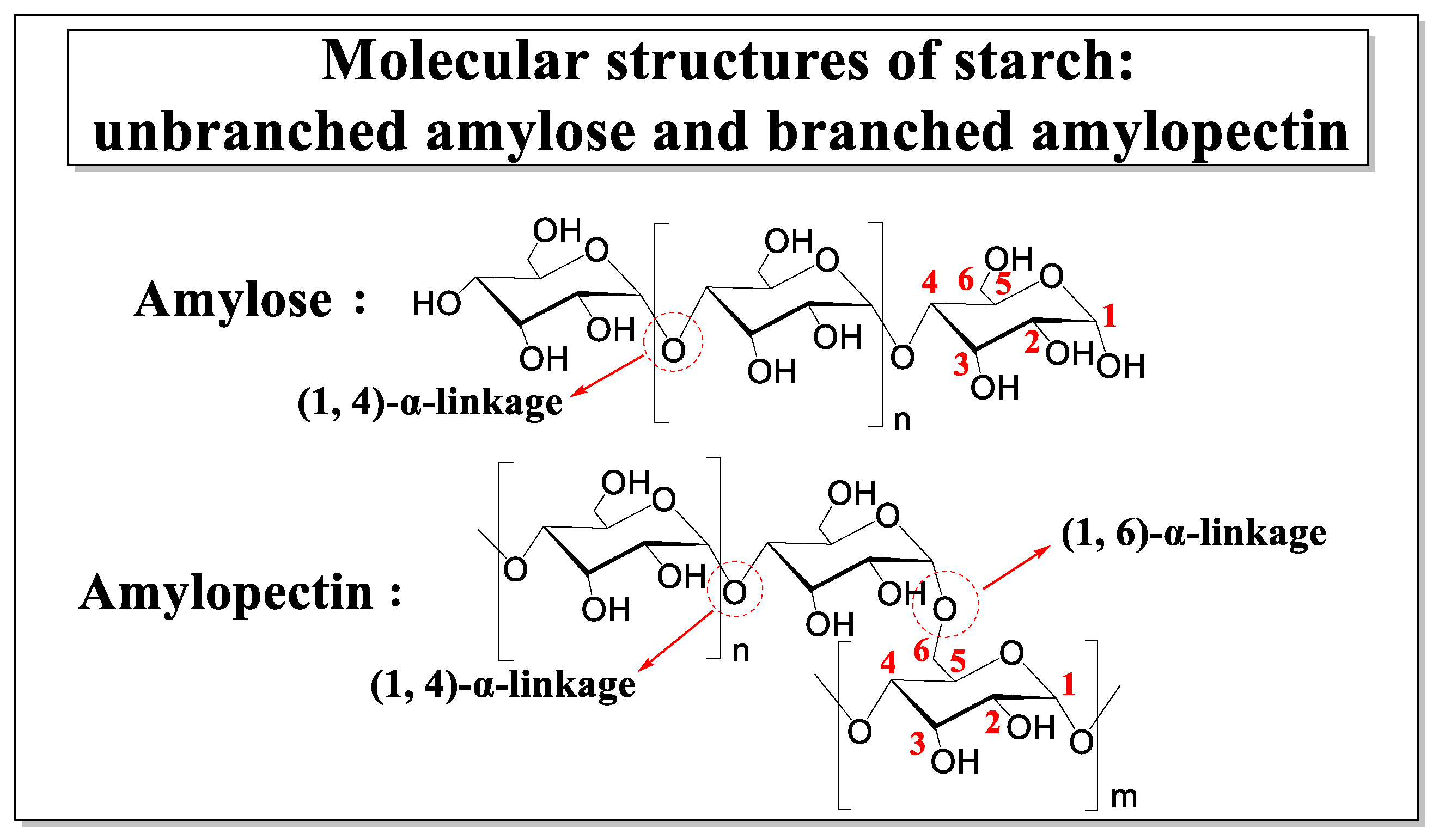
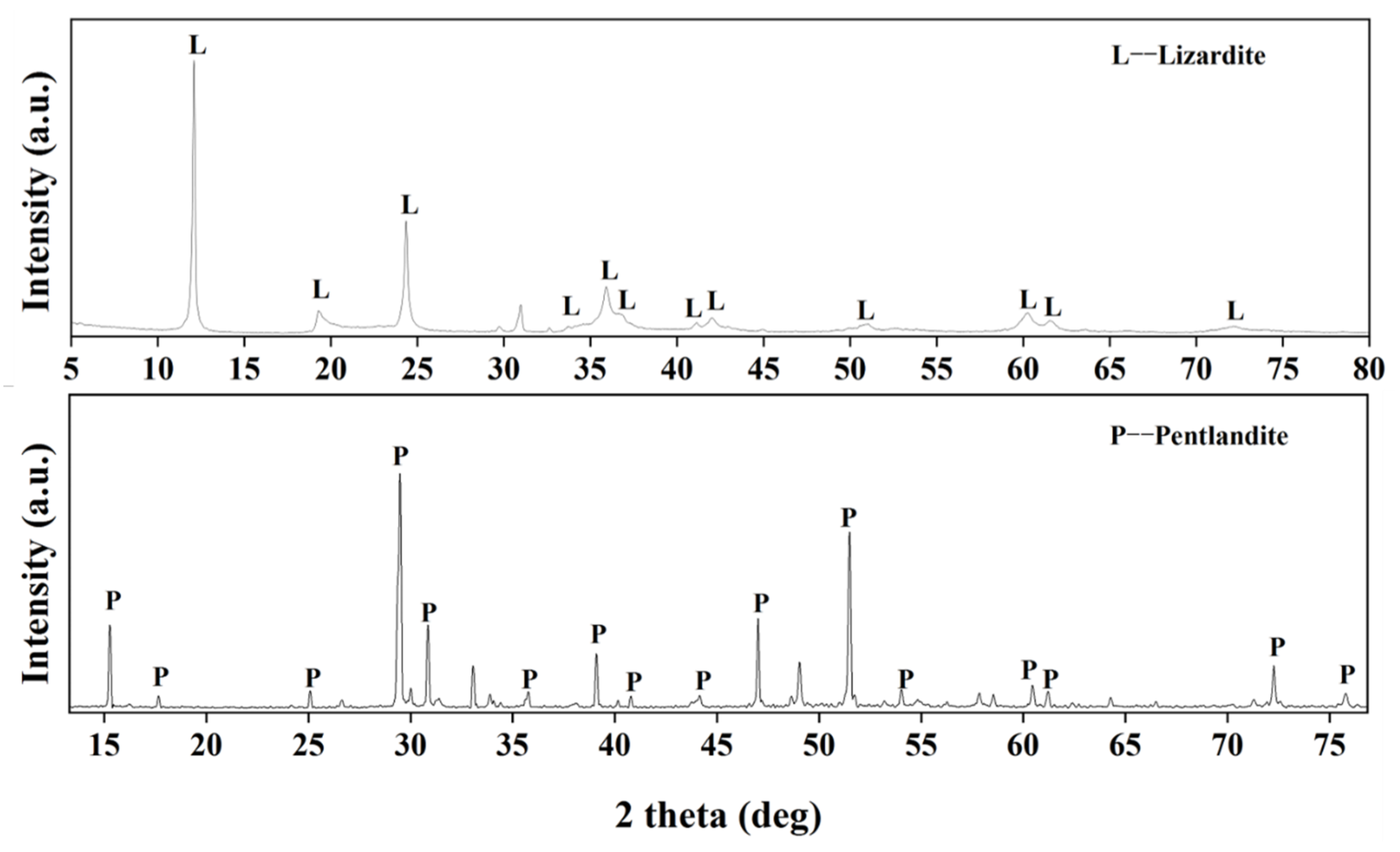
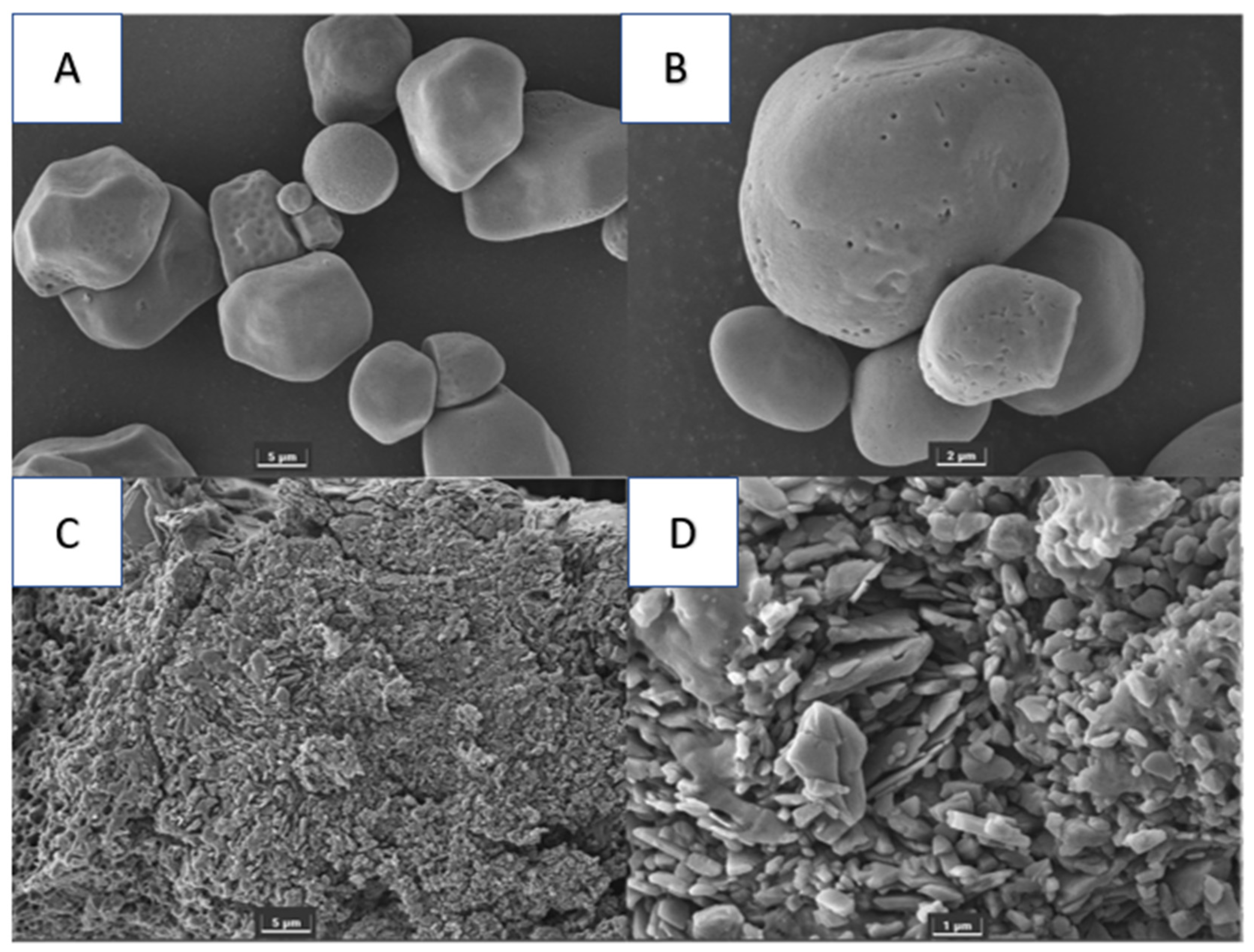


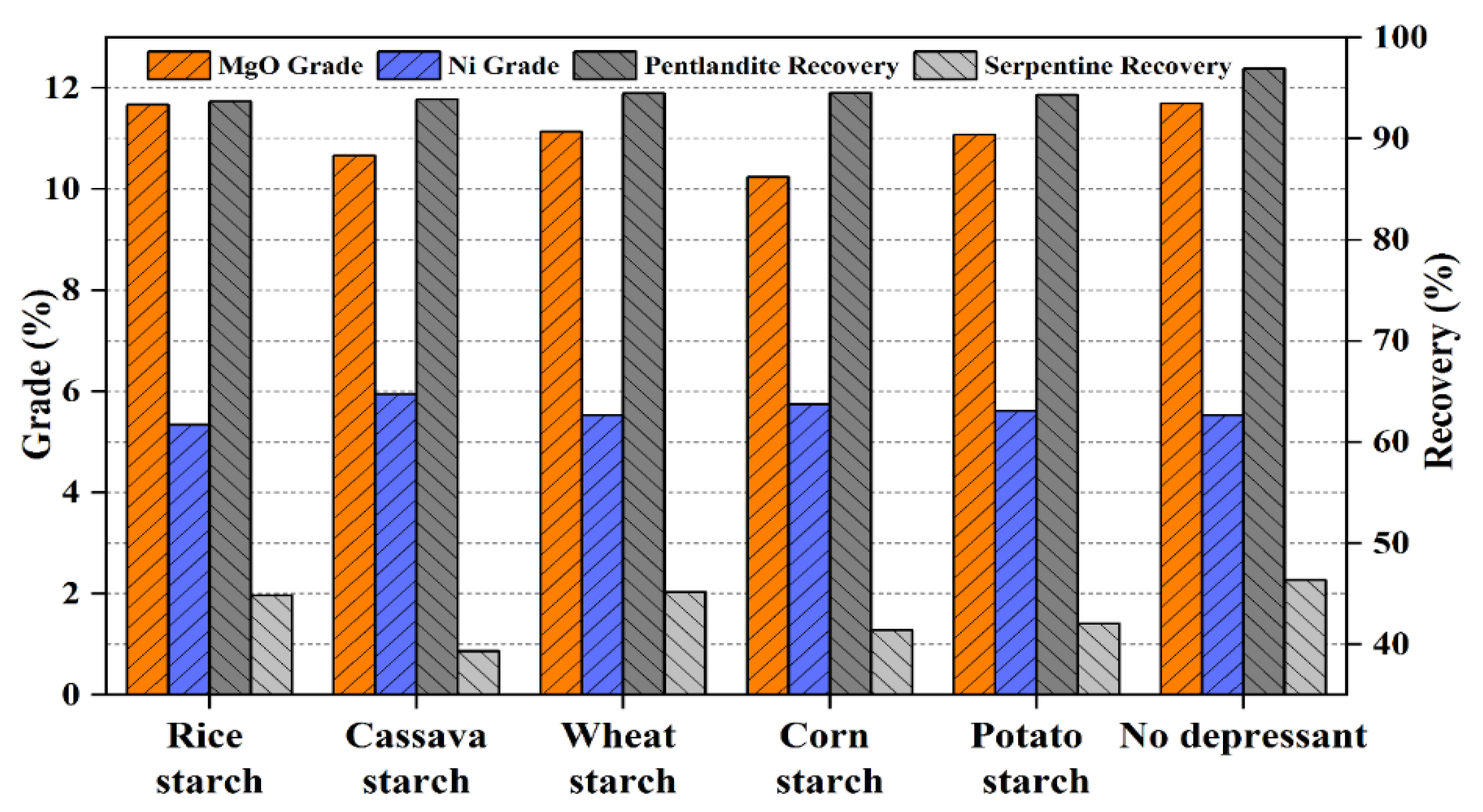
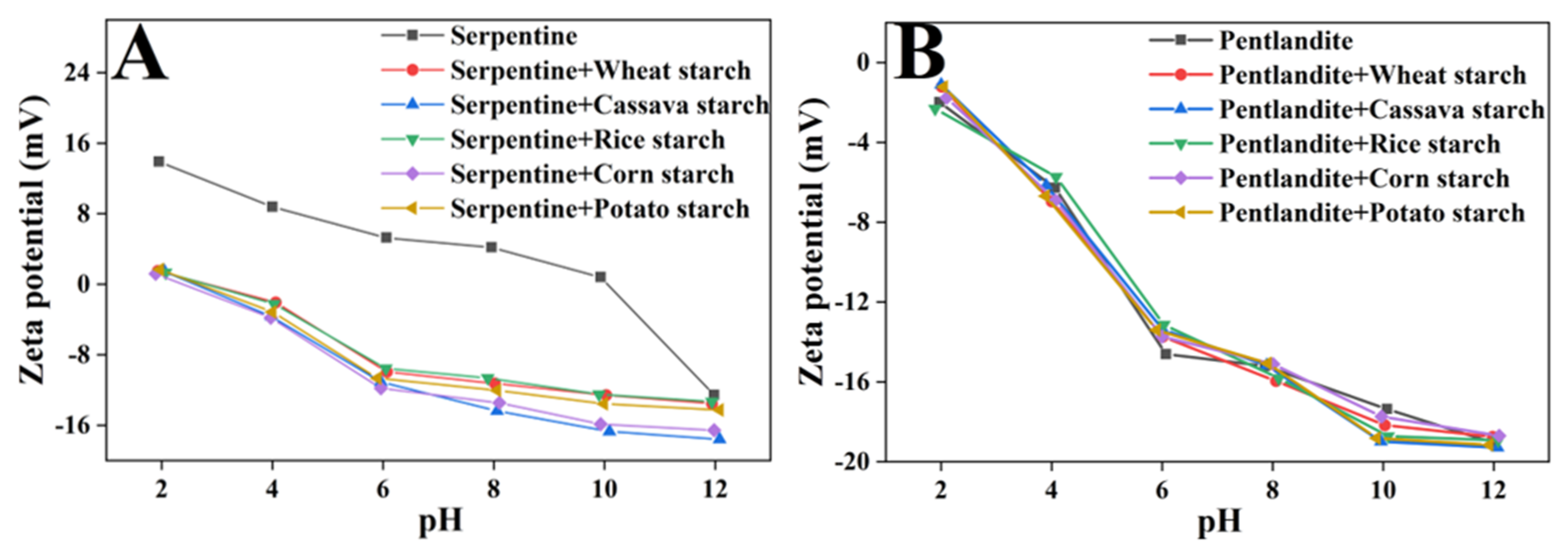
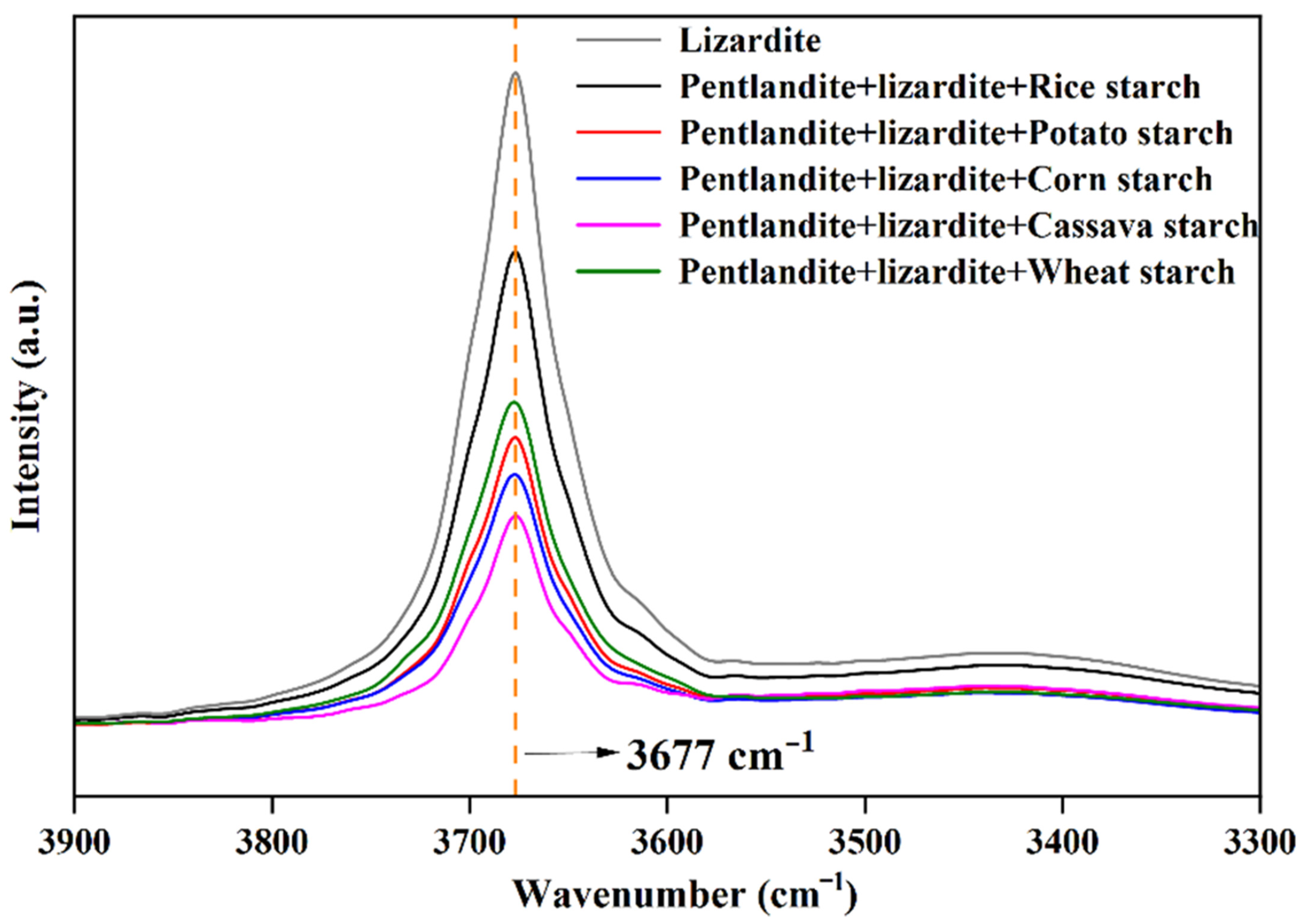
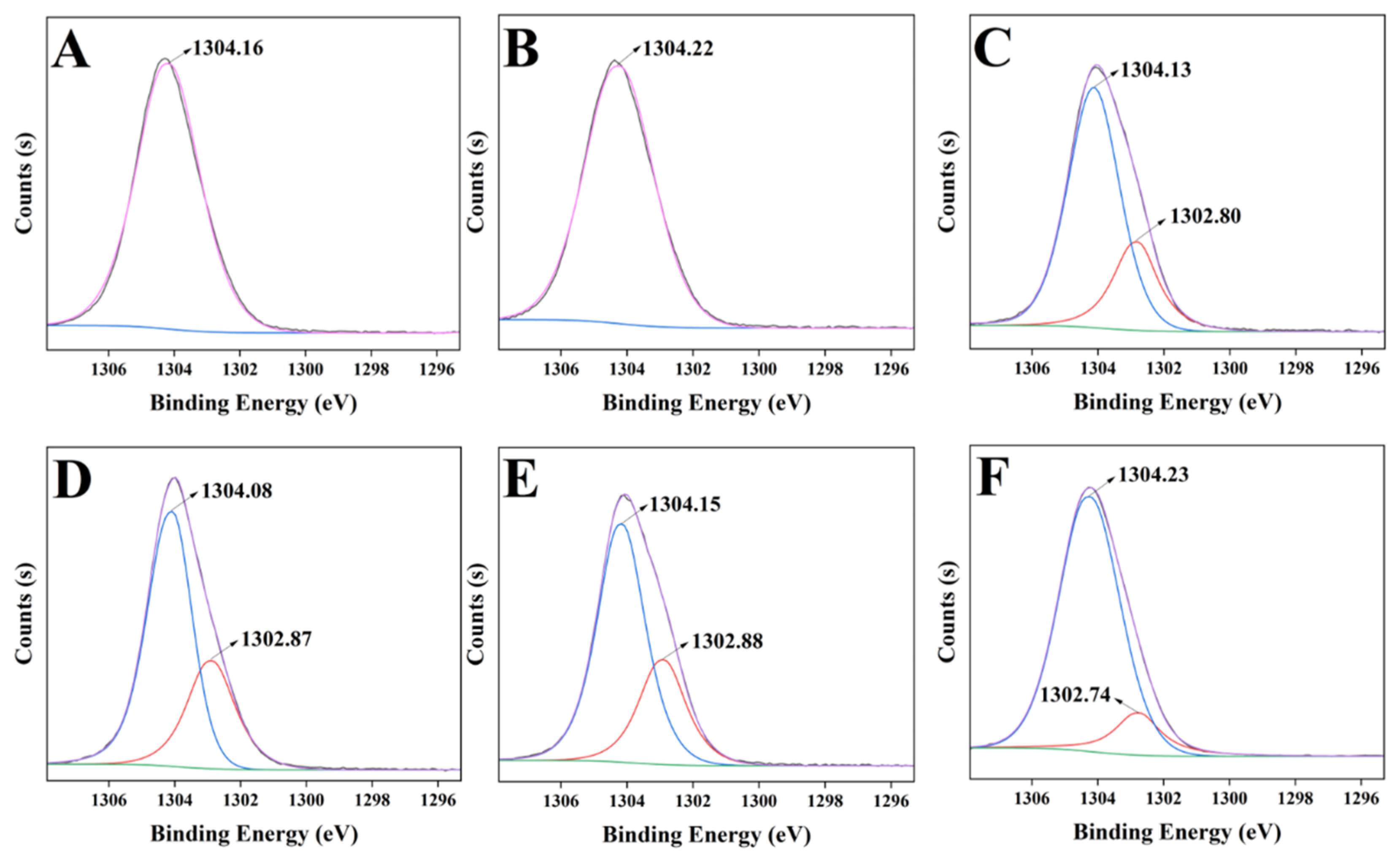

| Species | Average CL | % Distribution | |||
|---|---|---|---|---|---|
| DP 6–12 | DP 13–24 | DP 25–36 | DP ≥ 37 | ||
| Corn starch | 21.21 | 26.69 | 46.62 | 13.71 | 12.98 |
| Wheat starch | 19.97 | 28.62 | 47.89 | 14.01 | 9.48 |
| Cassava starch | 22.27 | 19.23 | 51.76 | 14.98 | 14.03 |
| Rice starch | 19.48 | 29.62 | 49.12 | 11.15 | 10.11 |
| Potato starch | 20.75 | 23.47 | 51.83 | 13.74 | 10.96 |
| Depressant | MgO Grade (%) | MgO Recovery (%) | Ni Grade (%) | Ni Recovery (%) |
|---|---|---|---|---|
| No depressant | 11.69 | 46.35 | 5.53 | 96.92 |
| Wheat starch | 11.67 | 44.85 | 5.34 | 93.68 |
| Cassava starch | 10.66 | 39.32 | 5.94 | 93.86 |
| Rice starch | 11.13 | 45.18 | 5.53 | 94.47 |
| Corn starch | 10.24 | 41.38 | 5.75 | 94.52 |
| Potato starch | 11.08 | 42.03 | 5.62 | 94.34 |
| Sample | Mg 1s Binding Energy (eV) | Species Distribution (%) |
|---|---|---|
| Serpentine | — | 0.00 |
| 1304.16 | 100.00 | |
| Serpentine + Rice starch | — | 0.00 |
| 1304.22 | 100.00 | |
| Serpentine + Potato starch | 1302.80 | 25.71 |
| 1304.13 | 74.29 | |
| Serpentine + Cassava starch | 1302.87 | 31.76 |
| 1304.08 | 68.24 | |
| Serpentine + Corn starch | 1302.88 | 30.26 |
| 1304.15 | 69.74 | |
| Serpentine + Wheat starch | 1302.74 | 13.33 |
| 1304.23 | 86.67 |
Publisher’s Note: MDPI stays neutral with regard to jurisdictional claims in published maps and institutional affiliations. |
© 2022 by the authors. Licensee MDPI, Basel, Switzerland. This article is an open access article distributed under the terms and conditions of the Creative Commons Attribution (CC BY) license (https://creativecommons.org/licenses/by/4.0/).
Share and Cite
Zhang, C.; Tan, Y.; Yin, F.; Wu, J.; Wang, L.; Cao, J. The Influence of Branched Chain Length on Different Causticized Starches for the Depression of Serpentine in the Flotation of Pentlandite. Minerals 2022, 12, 1081. https://doi.org/10.3390/min12091081
Zhang C, Tan Y, Yin F, Wu J, Wang L, Cao J. The Influence of Branched Chain Length on Different Causticized Starches for the Depression of Serpentine in the Flotation of Pentlandite. Minerals. 2022; 12(9):1081. https://doi.org/10.3390/min12091081
Chicago/Turabian StyleZhang, Chenxu, Yiping Tan, Fengxiang Yin, Jiamei Wu, Lichang Wang, and Jian Cao. 2022. "The Influence of Branched Chain Length on Different Causticized Starches for the Depression of Serpentine in the Flotation of Pentlandite" Minerals 12, no. 9: 1081. https://doi.org/10.3390/min12091081
APA StyleZhang, C., Tan, Y., Yin, F., Wu, J., Wang, L., & Cao, J. (2022). The Influence of Branched Chain Length on Different Causticized Starches for the Depression of Serpentine in the Flotation of Pentlandite. Minerals, 12(9), 1081. https://doi.org/10.3390/min12091081







